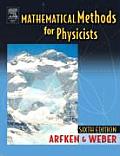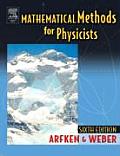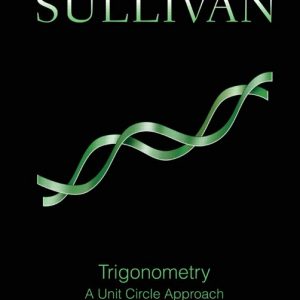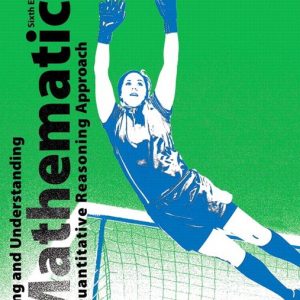This is completed downloadable of Solutions Manual to accompany Mathematical Methods for Physicists 6th edition 9780120598762

Product Details:
- ISBN-10 : 0120598760
- ISBN-13 : 978-0120598762
- Author:
This best-selling title provides in one handy volume the essential mathematical tools and techniques used to solve problems in physics. It is a vital addition to the bookshelf of any serious student of physics or research professional in the field. The authors have put considerable effort into revamping this new edition.
* Updates the leading graduate-level text in mathematical physics
* Provides comprehensive coverage of the mathematics necessary for advanced study in physics and engineering
* Focuses on problem-solving skills and offers a vast array of exercises
* Clearly illustrates and proves mathematical relations
New in the Sixth Edition:
* Updated content throughout, based on users’ feedback
* More advanced sections, including differential forms and the elegant forms of Maxwell’s equations
* A new chapter on probability and statistics
* More elementary sections have been deleted
Table of Content:
- Chapter 1. Vector Analysis
- 1.1 Definitions, Elementary Approach
- 1.2 Rotation of the Coordinate Axes
- 1.3 Scalar or Dot Product
- 1.4 Vector or Cross Product
- 1.5 Triple Scalar Product, Triple Vector Product
- 1.6 Gradient, V
- 1.7 Divergence, V
- 1.8 Curl, V×
- 1.9 Successive Applications of V
- 1.10 Vector Integration
- 1.11 Gauss’ Theorem
- 1.12 Stokes’ Theorem
- 1.13 Potential Theory
- 1.14 Gauss’ Law, Poisson’s Equation
- 1.15 Dirac Delta Function
- 1.16 Helmholtz’s Theorem
- Additional Readings
- Chapter 2. Vector Analysis in Curved Coordinates and Tensors
- 2.1 Orthogonal Coordinates in R3
- 2.2 Differential Vector Operators
- 2.3 Special Coordinate Systems: Introduction
- 2.4 Circular Cylinder Coordinates
- 2.5 Spherical Polar Coordinates
- 2.6 Tensor Analysis
- 2.7 Contraction, Direct Product
- 2.8 Quotient Rule
- 2.9 Pseudotensors, Dual Tensors
- 2.10 General Tensors
- 2.11 Tensor Derivative Operators
- Additional Readings
- Chapter 3. Determinants and Matrices
- 3.1 Determinants
- 3.2 Matrices
- 3.3 Orthogonal Matrices
- 3.4 Hermitian Matrices, Unitary Matrices
- 3.5 Diagonalization of Matrices
- 3.6 Normal Matrices
- Additional Readings
- Chapter 4. Group Theory
- 4.1 Introduction to Group Theory
- 4.2 Generators of Continuous Groups
- 4.3 Orbital Angular Momentum
- 4.4 Angular Momentum Coupling
- 4.5 Homogeneous Lorentz Group
- 4.6 Lorentz Covariance of Maxwell’s Equations
- 4.7 Discrete Groups
- 4.8 Differential Forms
- Additional Readings
- Chapter 5. Infinite Series
- 5.1 Fundamental Concepts
- 5.2 Convergence Tests
- 5.3 Alternating Series
- 5.4 Algebra of Series
- 5.5 Series of Functions
- 5.6 Taylor’s Expansion
- 5.7 Power Series
- 5.8 Elliptic Integrals
- 5.9 Bernoulli Numbers, Euler–Maclaurin Formula
- 5.10 Asymptotic Series
- 5.11 Infinite Products
- Additional Readings
- Chapter 6. Functions of a Complex Variable I Analytic Properties, Mapping
- 6.1 Complex Algebra
- 6.2 Cauchy–Riemann Conditions
- 6.3 Cauchy’s Integral Theorem
- 6.4 Cauchy’s Integral Formula
- 6.5 Laurent Expansion
- 6.6 Singularities
- 6.7 Mapping
- 6.8 Conformal Mapping
- Additional Readings
- Chapter 7. Functions of a Complex Variable II
- 7.1 Calculus of Residues
- 7.2 Dispersion Relations
- 7.3 Method of Steepest Descents
- Additional Readings
- Chapter 8. The Gamma Function (Factorial Function)
- 8.1 Definitions, Simple Properties
- 8.2 Digamma and Polygamma Functions
- 8.3 Stirling’s Series
- 8.4 The Beta Function
- 8.5 Incomplete Gamma Function
- Additional Readings
- Chapter 9. Differential Equations
- 9.1 Partial Differential Equations
- 9.2 First-Order Differential Equations
- 9.3 Separation of Variables
- 9.4 Singular Points
- 9.5 Series Solutions—Frobenius’ Method
- 9.6 A Second Solution
- 9.7 Nonhomogeneous Equation—Green’s Function
- 9.8 Heat Flow, or Diffusion, PDE
- Additional Readings
- Chapter 10. Sturm–Liouville Theory—Orthogonal Functions
- 10.1 Self-Adjoint ODEs
- 10.2 Hermitian Operators
- 10.3 Gram–Schmidt Orthogonalization
- 10.4 Completeness of Eigenfunctions
- 10.5 Green’s Function—Eigenfunction Expansion
- Additional Readings
- Chapter 11. Bessel Functions
- 11.1 Bessel Functions of the First Kind, Jv(x)
- 11.2 Orthogonality
- 11.3 Neumann Functions
- 11.4 Hankel Functions
- 11.5 Modified Bessel Functions, Iv(x) and Kv(x)
- 11.6 Asymptotic Expansions
- 11.7 Spherical Bessel Functions
- Additional Readings
- Chapter 12. Legendre Functions
- 12.1 Generating Function
- 12.2 Recurrence Relations
- 12.3 Orthogonality
- 12.4 Alternate Definitions
- 12.5 Associated Legendre Functions
- 12.6 Spherical Harmonics
- 12.7 Orbital Angular Momentum Operators
- 12.8 Addition Theorem for Spherical Harmonics
- 12.9 Integrals of Three Y’s
- 12.10 Legendre Functions of the Second Kind
- 12.11 Vector Spherical Harmonics
- Additional Readings
- Chapter 13. More Special Functions
- 13.1 Hermite Functions
- 13.2 Laguerre Functions
- 13.3 Chebyshev Polynomials
- 13.4 Hypergeometric Functions
- 13.5 Confluent Hypergeometric Functions
- 13.6 Mathieu Functions
- Additional Readings
- Chapter 14. Fourier Series
- 14.1 General Properties
- 14.2 Advantages, Uses of Fourier Series
- 14.3 Applications of Fourier Series
- 14.4 Properties of Fourier Series
- 14.5 Gibbs Phenomenon
- 14.6 Discrete Fourier Transform
- 14.7 Fourier Expansions of Mathieu Functions
- Additional Readings
- Chapter 15. Integral Transforms
- 15.1 Integral Transforms
- 15.2 Development of the Fourier Integral
- 15.3 Fourier Transforms—Inversion Theorem
- 15.4 Fourier Transform of Derivatives
- 15.5 Convolution Theorem
- 15.6 Momentum Representation
- 15.7 Transfer Functions
- 15.8 Laplace Transforms
- 15.9 Laplace Transform of Derivatives
- 15.10 Other Properties
- 15.11 Convolution (Faltungs) Theorem
- 15.12 Inverse Laplace Transform
- Additional Readings
- Chapter 16. Integral Equations
- 16.1 Introduction
- 16.2 Integral Transforms, Generating Functions
- 16.3 Neumann Series, Separable (Degenerate) Kernels
- 16.4 Hilbert–Schmidt Theory
- Additional Readings
- Chapter 17. Calculus of Variations
- 17.1 A Dependent and an Independent Variable
- 17.2 Applications of the Euler Equation
- 17.3 Several Dependent Variables
- 17.4 Several Independent Variables
- 17.5 Several Dependent and Independent Variables
- 17.6 Lagrangian Multipliers
- 17.7 Variation with Constraints
- 17.8 Rayleigh–Ritz Variational Technique
- Additional Readings
- Chapter 18. Nonlinear Methods and Chaos
- 18.1 Introduction
- 18.2 The Logistic Map
- 18.3 Sensitivity to Initial Conditions and Parameters
- 18.4 Nonlinear Differential Equations
- Additional Readings
- Chapter 19. Probability
- 19.1 Definitions, Simple Properties
- 19.2 Random Variables
- 19.3 Binomial Distribution
- 19.4 Poisson Distribution
- 19.5 Gauss’ Normal Distribution
- 19.6 Statistics
- Additional Readings
- General References
- Index





